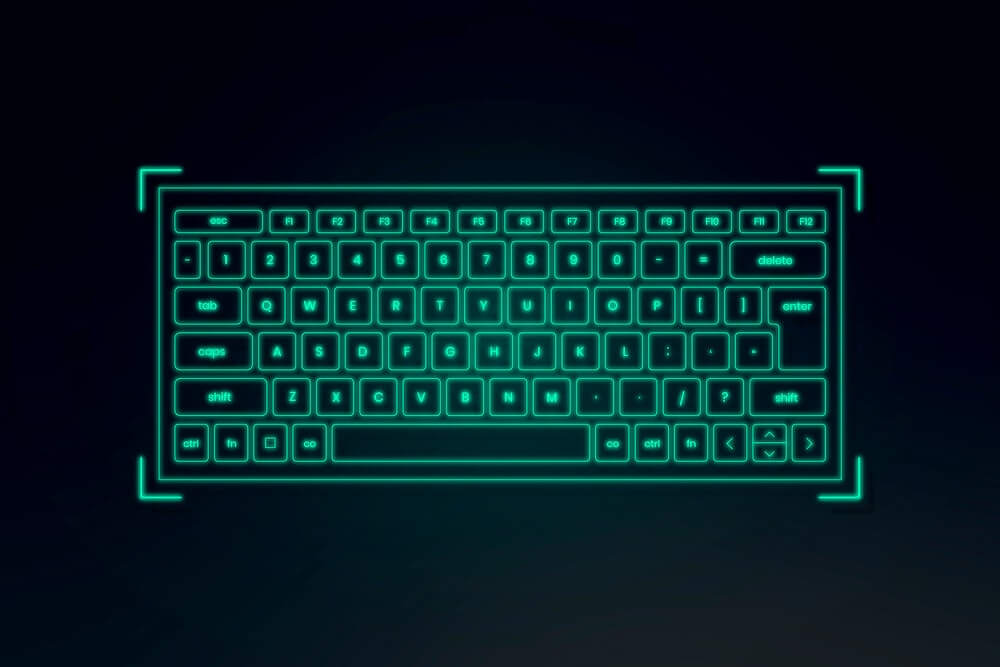This article lists over 200+ Keyboard Shortcuts on Windows to Improve Your Productivity while making use of your Windows PC. Keyboard shortcuts for windows can ease the way you put in words and signs in a short time avoiding unnecessary lengthy procedures. Keyboard shortcuts can help boost your productivity if your daily job relies heavily on using a computer device most especially a Windows operating device. Using and mastering Windows shortcut keys will not only help you get your work done quickly, but it will also improve your efficiency at all times. You can also buy best keyboard online here.
Using keyboard shortcuts can greatly reduce repetitive strain, and help you stay focused. The shortcut keys are faster than moving your hands from distant buttons on a keyboard, highlighting with the mouse, choosing copy from the file menu, and then returning to the keyboard.
Table of Contents
- Below are a list of over 200+ Keyboard Shortcuts on Windows. It would be great to have them in memory for use:
- Below are the keyboard shortcuts in the File Explorer area:
- Windows Key keyboard shortcuts
- Command Prompt keyboard shortcuts
- Dialog Box keyboard shortcuts
- Taskbar keyboard shortcuts
- Multi-tasking keyboard shortcuts
Below are a list of over 200+ Keyboard Shortcuts on Windows. It would be great to have them in memory for use:

Ctrl + X Cut a selection
Ctrl + C or Ctrl + INs Copy a selection
Ctrl + V or Shift + Ins Paste the selection
Also Read
Ctrl + Z Undo the last action
Alt + F4 Close or exit the active app
F2 Rename the selected item
F6 Cycle through the on-screen elements
F10 Activate the Menu bar in the current app
Alt + F8 Display your password on the login screen
Alt + Esc Cycle through apps in their opening order
Alt + *Underlined letter Perform the action for the underlined letter
Alt + Enter Display the Properties for the selected item
Alt + Spacebar Show the quick menu for the active window
Alt + ← Navigate back
Alt + → Navigate forward
Alt + Page Up Scroll up one screen
Alt + Page Down Scroll down one screen
Ctrl + F4 Close the active tab or document
Ctrl + A Select all items or content in the window
Ctrl + D or Del Delete the selected item into the Recycle Bin
Ctrl + R or F5 Refresh the active window
Ctrl + Y Redo the last undo-ed action
Ctrl + → Navigate the cursor to the beginning of the next word
Ctrl + ← Navigate the cursor to the beginning of the previous word
Ctrl + ↓ Navigate the cursor to the beginning of the next paragraph
Ctrl + ↑ Navigate the cursor to the beginning of the previous paragraph
Ctrl + Alt + Shift + Arrow keys Move a group or a tile in focus in either direction on the Start menu
Ctrl + Arrow keys + Spacebar Select multiple items in a window or on the desktop
Ctrl + Shift + Any arrow key Select a block of text
Ctrl + Shift + Esc Open Task Manager
Ctrl + Shift Switch between the available keyboard layouts
Ctrl + Spacebar Turn on/off the Chinese input method editor
Shift + F10 Display the context menu for the selected item
Shift + Any arrow key Select text in the document or multiple items in a window or on the desktop
Shift + Del Delete the selected item directly without first sending it to the Recycle Bin
→ Open the menu to the right or open a submenu
← Open the menu to the left or close a submenu
Esc Stop or abandon the current task
File Explorer keyboard shortcuts
Below are the keyboard shortcuts in the File Explorer area:

Press the keys to perform the action
Alt + D or F4 Select the address bar
Ctrl + E or Ctrl + F or F3 Select the search box
Ctrl + N Open a new window
Ctrl + W Close the current window
Ctrl + Mouse scroll Change the size and appearance of icons
Ctrl + Shift + E Display all sub-folders of the parent folder
Ctrl + Shift + N Create a new folder
Num Lock + * Display all subfolders of the selected folder
Num Lock + + Display all contents of the selected folder
Num Lock + – Collapse the selected folder
Alt + P Display the preview panel
Alt + Enter Open the Properties for the selected item
Alt + → Go to the next folder
Alt + ↑ Go to the parent folder
Alt + ← or Backspace Go to the previous folder
→ Expand the selected folder (if it’s collapsed) or select its sub folder
← Collapse the selected folder (if it’s expanded) or select its parent folder
End Scroll to the bottom of the current window
Home Scroll to the top of the current window
F11 Maximize or minimize the current window
Windows Key keyboard shortcuts

Here are the keyboard shortcuts starting with the Win (Windows) key that help you open numerous tools and achieve various tasks by pressing a few keys.
Press the keys to perform the action
Win or Ctrl + Esc Open or close the Start menu
Win + A Open the Action center
Win + B Focus the notification area
Win + Shift + C Open Cortana in listening mode
Win + D Show or hide the desktop
Win + Alt + D Show or hide the Calendar quick action
Win + E Open the File Explorer
Win + F Open the Feedback Hub
Win + G Open the Game bar when playing a game
Win + H Open the Share charm
Win + I Open the Settings app
Win + J Set focus to a Windows tip if available
Win + K Open the Connect quick action
Win + L Lock your PC or switch user accounts
Win + M Minimize all visible windows
Win + O Lock the device orientation
Win + P Select a presentation display mode
Win + R Launch the Run tool
Win + S Open search (aka Cortana)
Win + T Cycle through apps shown on the taskbar
Win + U Open the Ease of Access Center
Win + V Cycle through available notifications
Win + Shift + V Cycle through available notifications in reverse order
Win + X Open the Quick Links menu
Win + Z Show the commands present in a full-screen mode app
Win + , Peek at the desktop temporarily
Win + Pause Show the System Properties dialog box
Win + Ctrl + F Search for computers on your network
Win + Shift + M Restore or expand all minimized windows
Win + Number Start or switch to the app pinned to the taskbar in the position equal to the number
Win + Shift + Number Start the app (even if opened) pinned to the taskbar in the position equal to the number
Win + Ctrl + Number Switch to the recent active window of the app pinned to the taskbar in the position equal to the number
Win + Alt + Number Show the Jump List for the app pinned to the taskbar in the position equal to the number
Win + Ctrl + Shift + Number Start a new instance of the app (as an administrator) located on the taskbar in the position equal to the number
Win + ↑ Maximize the active window
Win + ↓ Minimize the active window
Win + ← Maximize or place the active window to the left side of the screen
Win + → Maximize or place the active window to the right side of the screen
Win + Home Minimize or restore all windows except the active application window
Win + Shift + ↑ Stretch the active window vertically on the screen while maintaining width
Win + Shift + ↓ Minimize or restore the active window vertically while maintaining the width
Win + Shift + ← or → Move the current window from one monitor to another (if connected)
Win + Spacebar Change input language plus keyboard layout
Win + Ctrl + Spacebar Switch to the previously chosen/set input
Win + Enter Open the Narrator
Win + / Start IME re-conversion
Win + + Zoom in using the Magnifier
Win + – Zoom out using the Magnifier
Win + Esc Exit the Magnifier
Command Prompt keyboard shortcuts
Press the keys to perform the action
Ctrl + C or Ctrl + Insert Copy the selected text
Ctrl + V or Shift + Insert Paste the selected text
Ctrl + M Enter the Mark mode
Alt + Selection key Start selection in block mode
Arrow Keys Move the cursor in the specified direction
Page Up Scroll the cursor up by one page
Page Down Scroll the cursor down by one page
Ctrl + Home Move the cursor to the start of the buffer (in Mark mode)
Ctrl + End Move the cursor to the end of the buffer (in Mark mode)
Ctrl + ↑ Scroll one line up in the output history
Ctrl + ↓ Scroll one line down in the output history
Ctrl + Home Move the command viewport to the top of the buffer (in History navigation) and delete all characters to the left of the cursor
Ctrl + End Move the command viewport to the command line (in History navigation) and delete all characters to the right of the cursor
Dialog Box keyboard shortcuts
Keyboard shortcuts for controlling and handling the dialog boxes using just the keyboard.
Press the keys to perform the action
F4 Show the items in the active list
Ctrl + Tab Switch the tabs in forward direction
Ctrl + Shift + Tab Switch the tabs in backward direction
Ctrl + N (1-9) Switch to the nth tab directly
Tab Move forward through options
Shift + Tab Move backward through options
Alt + *Underlined letter Perform the command (or select the option) that is used with that letter
Spacebar Click or select an active button, or select or clear an active check box
Backspace Go to the parent folder if it’s selected in the Open or Save As dialog box
Arrow Keys Select or move to a button from the list of active buttons
Taskbar keyboard shortcuts

Here are some keyboard shortcuts for opening apps and performing other actions on the Taskbar:
Press the keys to perform the action
Shift + Click a Taskbar button Open a new instance of an app quickly
Ctrl + Shift + Click a Taskbar button Open an app (as an administrator)
Shift + Right-click a taskbar button Show the window quick menu for the app
Shift + Right-click a grouped taskbar button Show the window quick menu for the app group
Ctrl + Rlick a grouped taskbar button Cycle through the concurrent opened windows of the app group
Multi-tasking keyboard shortcuts
Also read Technical Features You Will Need in an iMovie Alternative for Windows.
Multi-tasking shortcut keys most used on Windows 10
Press the keys to perform the action
Alt + Tab Switch between open apps
Win + Tab Open the Task View
Win + Ctrl + D Add a virtual desktop
Win + Ctrl + ← Switch to the virtual desktop on the left
Win + Ctrl + → Switch to the virtual desktop on the right
Win + Ctrl + F4 Close the active or current virtual desktop
How to Type Faster: Tips and Tricks to Master the Keyboard
Using shortcut keys as an alternative to the mouse when working on Windows, helps anyone to open, close, and navigate through the Start menu, desktop, menus, dialog boxes, and Web pages using keyboard shortcuts. Keyboard shortcuts makes gives you a better experience when interacting with your PC.
Some keyboard shortcuts may not work if StickyKeys is turned on in Accessibility Options.
If you are connected to Windows through Microsoft Terminal Services Client, some shortcuts have changed.






